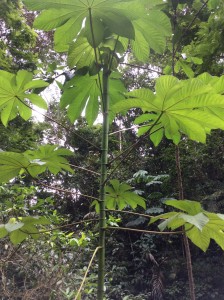Day 23 in Costa Rica, and man oh man has it been a whirlwind of an experience thus far! After two weeks of vacationing, it was straight into the rainforest to learn so much about the species at work all around us in the field.
Trying to focus on anything but your feet for a bullet ant (Paraponera clavata) or fer-de-lance (Bothrops asper) can be impossible at times, especially for the easily frightened. During every hour of the day there will be some organism somewhere very close to you putting in a hard day’s work of acquiring nutrients, sunlight, or finding a safe haven. However, for many of us students new to this environment, keeping up with observing the multitude of species that could potentially be out and about can be an arduous task. This becomes especially true for mammals, amphibians, and reptiles. The mechanisms they have for disguise, etc. makes observing them extra tricky. There is another piece of the puzzle though beyond those elusive species. These species might not be the main priority of photographers that travel to Costa Rica for the flashy, hard-to-come-by species. However, without them, they would be hard-pressed to find any of their difficult to find species around. That’s right, those oh-so-green species we rely on for so much, yet often pay little credit to: the trees.
For these reasons and many more, in my first week or so studying in Costa Rica, I have grown more fascinated with trees than I ever have been before. Back in Texas, tree species can vary greatly, but mostly when traveling between large regions. In Costa Rica, the biodiversity is so incredibly high that many species can occupy a few hectares. The abundance of life that is often sustained here is incredible and vast which lead the authors of Tropical Nature to state that “there are few people who, even after a lifetime of study can confidently identify most of the trees in a patch of tropical American rain forest” (Forsyth and Miyata, p. 1).
There has been one species that has become easily identifiable for me, despite not knowing a ton about trees, especially trees in the tropics. The species is Cecropia of the family Urticaceae. There are four species of Cecropia in Costa Rica, with C. insignis, C. obtusifolia, and C. peltata being the ones that I have become familiar with. The fun thing about this species is that they share a relationship mutualistic relationship with Azteca ants, in which each species benefits from the interactions with the other. Currently, I am working on developing a study to identify how often the Azteca occupy Cecropia within different forest types. Hopefully during the preliminary portion of this study (and entirety of it, really), bites from the aggressive Azteca will be avoided. Stay tuned for more as this research project progresses during our time in the lovely country of Costa Rica!
